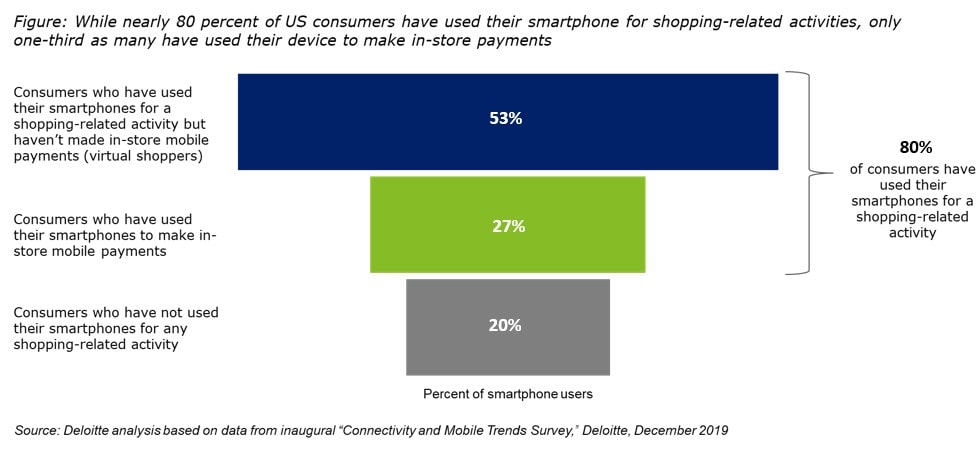Mobile shopping and payment trends has been saved

Perspectives
Mobile shopping and payment trends
Consumers using mobile to shop, but in-store mobile payments are another matter
While most consumers rely on their smartphone to shop, only about one-third as many have used their device for in-store payments. How can companies encourage consumers to try mobile payments?
The popularity of smartphones as shopping devices has grown dramatically. Data from the inaugural edition of Deloitte’s “Connectivity and Mobile Trends Survey” (CMT) shows that nearly 80 percent of US consumers use their smartphones for shopping-related activities.1

This trend applies to holiday shopping as well. In fact, the “2019 Deloitte holiday retail survey” revealed that smartphones are fast becoming consumers’ go-to platform for holiday purchases. It further highlighted that while smartphone usage for holiday shopping continues to grow, the same is not true for other devices.2
Yet, although most US consumers are using their mobile phones to research items, check prices, and make online purchases, in-store payments are another matter. CMT survey data indicates that only 27 percent of US consumers have ever used their smartphone for making in-store payments, and only 19 percent make payments with it on a monthly basis.3 By comparison, more than 80 percent of smartphone owners in China use their device to make in-store payments.4
Why are smartphones so widely used to make in-store payments in China? For starters, China is a mobile-first market, where the majority of consumers rely on their smartphones as the primary way to connect to the internet. Second, credit card penetration was relatively low when usage of mobile devices for in-store payments began to emerge in the country.5
Meanwhile, despite a few success stories, adoption of in-store mobile payments has been slow in the United States.6 CMT survey data highlights two key reasons for this: 1) Unlike China, credit card penetration is high in the United States, and consumers don’t mind using traditional payment methods (cash/cards); and, 2) security and privacy concerns deter US consumers.7
Several stakeholders have a vested interest in seeing greater adoption of mobile-based in-store payments in the United States. Broader adoption likely creates new opportunities for service providers in the payments ecosystem. For mobile wallet players, it offers the potential to become an intermediary in the $3.1 trillion US offline retail market.8 For retailers, it can result in increased traffic and better customer experience.9 Mobile payments also facilitate advanced real-time customer analytics, which directly brings telecommunications, media, and technology (TMT) companies into play.10
Given these benefits, how can companies increase adoption of mobile in-store payments in the United States? The good news for service providers is that around 77 percent of “virtual shoppers” are willing to use in-store mobile payments if they address certain considerations.11 Forty-six percent say that reward points/cash back could entice them to use mobile payments, while another 40 percent cite enhanced security features as having the potential to drive adoption.12 Research shows that many successful mobile-payment solutions in the United States have been built on top of strong reward programs.13
More than anything, greater adoption of mobile in-store payments by US consumers will depend on providers’ ability to convince consumers that there is greater value and security in using mobile payments. In addition to discounts and rewards, providers can consider using next-generation technologies such as 5G to enhance the overall mobile in-store shopping experience. With the Internet of Things (IoT) sensors, for example, consumers could potentially make payments in store aisles rather than having to wait in checkout lines. Application interoperability could further help connect the online and in-store shopping experiences.
While these potential solutions will likely be the levers that drive heightened adoption of mobile in-store payments among US consumers, the question remains: Are companies ready to address consumer perspectives?
This charticle authored by Shashank Srivastava on December 18, 2019.
Endnotes
1 As defined in the “Connectivity and Mobile Trends Survey,” shopping-related activity includes using a mobile device to compare prices, research product/user reviews, make a purchase through a mobile app/website remotely, or make an in-store mobile payment.
2 “2019 Deloitte holiday retail survey,” Deloitte, November 2019.
3 Deloitte analysis based on data from inaugural “Connectivity and Mobile Trends Survey,” Deloitte, December 2019.
4 Man-Chung Cheung, “China Mobile Payment Users 2019,” eMarketer, October 24, 2019.
5 Ibid.
6 Jim Kolchin, “Why the US Still Lags Behind China in Mobile Wallet Adoption,” Forbes, June 25, 2019.
7 Ibid.
8 Fareeha Ali, “US E-commerce sales grow 15.0 percent in 2018,” Digital Commerce 360, February 28, 2019.
9 “Consumers Who Use Mobile In-Store Are More Frequent Brick-and-Mortar Shoppers,” PYMNTS, May 22, 2019.
10 Tal Vinnik, “The Hidden Costs of Cash for Merchants,” Bypass, November 30, 2018.
11 Virtual shoppers: 53 percent of consumers who have used their smartphone for a shopping-related activity but not for in-store mobile payments. Deloitte analysis based on data from inaugural “Connectivity and Mobile Trends Survey,” Deloitte, December 2019.
12 Ibid.
13 Elisa Tavilla, “Rewarding Loyal Customers to Increase Mobile Payments Adoption,” Federal Reserve Bank of Boston, April 2017.
Recommendations
Software really is "eating the (tech) world"
The technology industry is increasingly driven by the growth of software, with hardware and devices taking a back seat
Product placement effectiveness on cord-cutters
How can streaming advertising take advantage?




